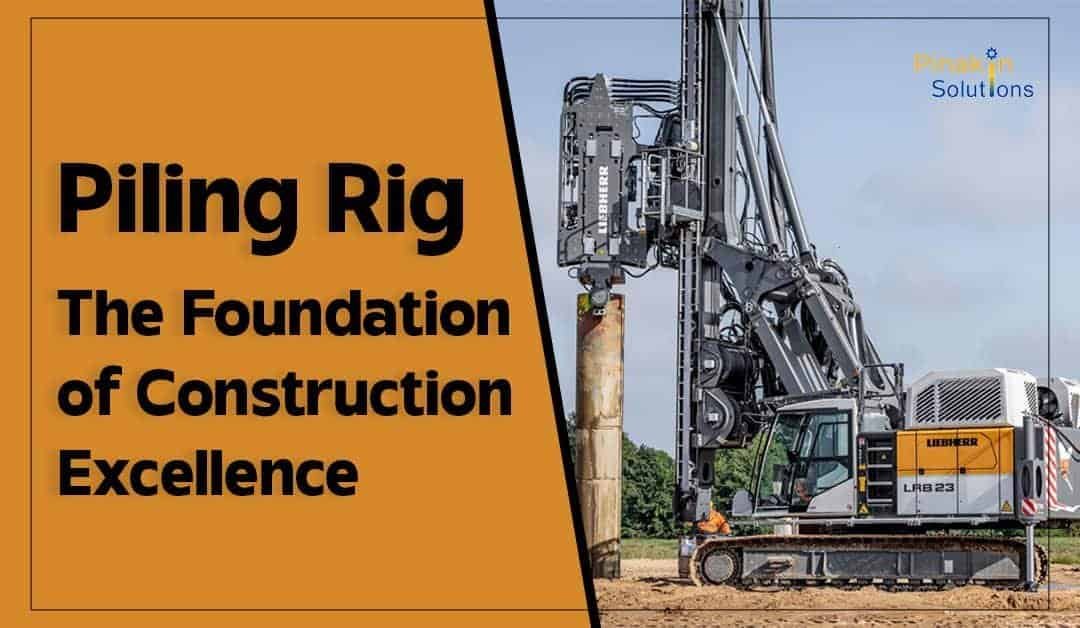When it comes to building towering skyscrapers, sturdy bridges, and resilient infrastructure, it’s the foundation that makes all the difference. Enter the world of piling rigs, the unsung heroes of construction. In this article, we’ll delve into the world of piling rigs, exploring their types, applications, benefits, and the pivotal role they play in shaping the modern world.
Table of Contents
ToggleThe Basics: What Is a Piling Rig?
A piling rig is a heavy-duty construction machine designed to drive piles deep into the ground to create stable foundations. These foundations are essential for supporting massive structures, ensuring they stand tall against the forces of nature. Piling rigs are engineering marvels, capable of handling the most demanding construction tasks with precision and power.
Types of Piling Rigs
Crawler Mounted Piling Rigs:
These versatile rigs are mounted on tracks, enabling them to navigate rough and uneven terrain.
Ideal for projects that require mobility and flexibility, such as bridge construction.
Piling Rigs with Vibratory Hammers:
These rigs use vibrations to drive piles into the ground efficiently.
Commonly used in projects where minimal noise and vibration are crucial, like urban construction.
Hydraulic Piling Rigs:
Known for their high power and speed, these rigs are often used in large-scale construction projects.
Hydraulic systems provide exceptional control and force for driving piles.
Rotary Piling Rigs:
These rigs are equipped with a rotating drill to bore into the ground and create piles. Ideal for projects that require deep foundation piles, such as high-rise buildings.
Applications of Piling Rigs
Piling rigs find applications across a wide spectrum of construction projects:
Skyscrapers and High-Rise Buildings:
Piling Rigs create deep foundation piles that support the weight of towering structures.
These rigs ensure the stability and safety of skyscrapers in bustling urban environments.
Bridges and Viaducts:
Piling rigs play a crucial role in constructing bridge foundations, ensuring they withstand heavy traffic loads.
They create stable abutments and piers for bridges that span rivers, valleys, and more.
Ports and Harbors:
Piling rigs are essential in building sturdy quays, jetties, and berths for ports.
They create foundations capable of withstanding the forces of waves and tides.
Retaining Walls and Underground Structures:
Piling rigs are used to create retaining walls that prevent soil erosion and provide structural support.
They also play a role in constructing underground parking garages and basements.
Benefits of Using Piling Rigs
Precision and Stability:
Piling rigs ensure accurate pile placement, resulting in stable and resilient foundations.
This precision is critical for the safety and longevity of structures.
Speed and Efficiency:
Piling rigs expedite the pile-driving process, reducing construction timelines.
Projects are completed faster, saving both time and money.
Minimized Environmental Impact:
Modern piling rigs are designed to generate minimal noise and vibration, reducing disruption to nearby areas.
They align with environmental regulations and community needs.
Versatility:
Different types of piling rigs cater to various project requirements, from urban construction to remote infrastructure development.

Must Read These Also.
- Vibratory Hammer: Unveiling the Power Behind Precise Foundation Construction
- Vibratory Hammer on Rent: Enhancing Construction Efficiency and Flexibility
Their adaptability makes them indispensable in the construction industry.
Frequently Asked Questions (FAQs)
Q1: What is a piling rig?
A piling rig is a specialized construction machine designed for driving piles into the ground to create deep and stable foundations for various structures, including buildings, bridges, and infrastructure projects. These rigs come in various types and are known for their precision and power in foundation construction.
Q2: What is the use of a pile rig?
The primary use of a pile rig is to create strong and stable foundations by driving piles into the ground. This is essential for supporting the weight of buildings, bridges, and other structures, ensuring their safety and longevity. Pile rigs are also employed in projects involving retaining walls, quays, and underground structures.
Q3: What are the components of a piling rig?
Piling rigs are complex machines with several key components, including:
- The rig’s mainframe, which houses the engine and control systems.
- The pile-driving mechanism can vary based on the type of rig and may include hydraulic systems, vibratory hammers, or rotary drills.
- Tracks or wheels for mobility, depending on the rig’s design.
- Operator controls and monitoring systems.
- Safety features and attachments specific to the rig’s intended use.
Q4: What is the cost of a piling rig machine?
The cost of a piling rig machine varies widely depending on several factors:
- Type: Different types of piling rigs, such as crawler-mounted, hydraulic, or vibratory hammer rigs, have different price ranges.
- Size and Capacity: The rig’s size and load-bearing capacity influence its cost.
- Brand and Model: Established brands and advanced models may come at a premium.
- Additional Features: Some rigs may include advanced features or attachments, which can affect the price.
- Market Conditions: Market demand and availability can also impact the cost of piling rigs.
New vs. Used: New rigs tend to be more expensive than used ones. It’s essential to consult with equipment suppliers and consider your project’s specific requirements when determining the cost of a piling rig.
Read More:
- Boom Placers: Enhancing Efficiency and Precision in Construction Projects
- Boom Placer Pros and Cons of Purchasing vs. Renting the Machine
Conclusion: Shaping the Future, One Pile at a Time
In the realm of construction, piling rigs are the unsung heroes that lay the groundwork for architectural marvels. These powerful machines, available in various forms, serve as the backbone of the construction industry.
With precision, speed, and a commitment to stability, piling rigs ensure that the towering skyscrapers, intricate bridges, and robust infrastructure we rely on are built on foundations that can withstand the test of time. As we look to the future of construction, one thing remains clear: piling rigs will continue to shape the world we live in, one pile at a time.





